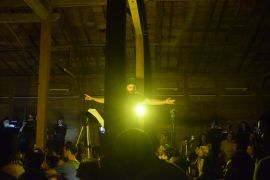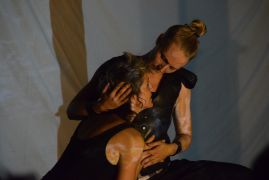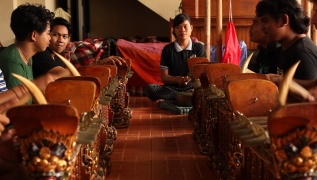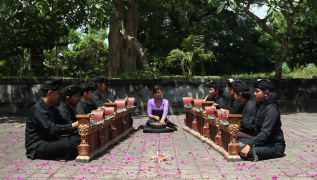As the only predominantly Hindu island in an otherwise majority-muslim Indonesia, Bali can take pride in a spectacularly unique cultural environment – one which continuously draws on ancient past while standing firmly in the 21st century.
In ancient times, it was primarily the influences coming from China and India which left its mark on Balinese culture, and later the Javanese Majapahit empire, which caused an influx of Javanese culture to Bali in the 13th and 14th century. However, throughout the colonial period, Bali was resistant to outside influences and Islam never left an imprint on its culture, as it did on other islands in Indonesia. Neither did Christianity, since Bali had long been overlooked by the West as underdeveloped, and it was only by the end of 19th century that the Dutch started to take active interest in it, driven by their effort to consolidate the East Indies.
Nevertheless, things started to change rapidly in the 20th century. In the first half of the 20th century, the many idiosyncrasies of Balinese culture and arts attracted many famous anthropologists, musicologists and artists – Clifford Geertz, Gregory Bateson, Margaret Mead, Colin McPhee and Walter Spies to name but a few – who have since provided us with concise, as well as idealized, reports of the cultural life and its development on the island and have played a fundamental role in fashioning wide-ranging representations of Balinese culture. Indeed, the romanticized cultural representations of Bali, such as the 1933 film Island of Demons, and more recently the blockbuster with Julia Roberts Eat, Pray Love, have indeed played a pivotal role in reinventing Bali as an attractive tourist destination.
In any case, the sheer fact that the form of Hinduism practiced in Bali, which is infused with Buddhism and animism, still maintains strong ties between art and religion in its frequent rituals and immersive communal ceremonies which include dance and music performances, simply creates the sense of a primordial ritual function of the arts, which has been long lost in the West. It was precisely for this primordial nature and physical rather than verbal means of expression of Balinese theatre that Antonin Artaud elevated it above European theatre of the 20th century: “One senses in the Balinese theater a state prior to language and which can choose its own: music, gestures, movements, words.”
Even though in Bali performing arts are traditionally considered a sacred accompaniment of religious ceremonies performed primarily for the enjoyment of the gods, due to the dramatic social changes caused mainly by the influx of tourists and Westerners to the island in the 20th century, the Balinese themselves have greatly expanded this canonical repertoire by either variation or addition and adapted such temple dances and gamelan compositions for secular purposes, i.e., for the sheer enjoyment of the public.
Moreover, this process ties into another unique aspect of Bali, which consists in the highly syncretic nature of Balinese culture. With its repeating cycles of cultural rebirth and reincarnation of ancient and nearly extinct cultural material, and with its propensity for drawing on diverse cultural practices and traditions and fusing them into unique art forms, Bali can take pride in an immensely dynamic cultural environment in which the ancient and the modern exist side by side, and in which many a Western artist will long to become immersed. A prime example of such processes at play is kecak, the so called “monkey chant,” with which some readers of the article might be familiar from Ron Fricke’s 1992 film Baraka: A World Beyond. In its secular form, it was introduced as late as the 1930s and draws on the Ramayana epic, which is relayed by means of several mediums: storytelling, dance and vocal chanting, employing the traditional art form of a male chorus called “kecak,” which incidentally gave its successor its name. Moreover, one interpretation of the origin of this highly eclectic art form even credits its creation to Walter Spies, a German primitivist painter who lived on the island in the 1930s and who apparently co-created kecak with people of the Bedulu village by fusing the ancient chorus he witnessed in a local performance of the Sanghyang Dedari dance with the Ramayana epic. Today, kecak is widely performed in temple settings, most famously in the Uluwatu temple, primarily for the appreciation of tourists.
But if we look at the wider picture, Balinese culture, together with the myriad of cultures of Indonesia, is now a subject of study of many programs in universities around the world and presently Javanese and Balinese gamelan rank among the most attractive fields of research of ethnomusicology. UCLA can take pride in the longest-running study program of gamelan, and it was also here that the internationally renowned ensemble focusing on the interpretation of the repertoire of Balinese and Javanese gamelan music, Gamelan Sekar Jaya was formed. Only in the USA, gamelan has become a valuable source of inspiration for many renowned composers, including Steve Reich, Philip Glass, Lou Harrison, Colin McPhee, and more recently, Evan Ziporyn, saxophonist and composer affiliated with the Bang in the Can All-Stars Ensemble, and Michael Tenzer, ethnomusicologist, composer, co-founder of the Sekar Jaya ensemble and author of Gamelan Gong Kebyar: The Art of Twentieth Century Balinese Music, so far the most concise publication on the most popular gamelan ensemble in Bali today.
Furthermore, in 2017 Indonesia also happened to be in the spotlight as the guest country of the biannual Europalia festival, which has been held since 1969 in Brussels and several other cities in Western Europe, and which every other year prepares a series of events that present the culture of a chosen guest country. Among the many musical and other events that took place that year, there also took place a contemporary composition for Balinese gamelan Aquifers by Balinese composer I Wayan Gde Yudane, created in collaboration with the well-known Balinese poet from Ubud, Ketut Yuliarsa which stood out for its structural sparseness, melodic temperance and soothing dynamics which are indeed very difficult to find in mainstream gamelan performances.
If there is one organization in the realm of experimental music in Bali which should not be spared a mention, it is Insiturec, an independent music label which houses a collective of Balinese as well as Western musicians and composers dedicated to exploring new sonic territories in gamelan and surpassing traditional compositional approaches. Several times a year Insiturec stages Insitu Sessions, a marathon event of recording sessions open to the public featuring new compositions performed by artists associated with the label which are afterwards made available on the label’s website.
In addition, an important bridge between Balinese arts and artists and art students from all around the world is supported by the Indonesian government-sponsored scholarship program Darmasiswa. With more than 54 participating universities all around Indonesia, the Darmasiswa program serves as a training ground for composers, dancers, visual artists and aficionados of Indonesian culture, providing western artists or art enthusiasts the opportunity to gain insight into the thousand cultures of this magnificent cultural archipelago.
Explorers of New Musical Territories
Pierre-Emmanuel Lévesque is a Canadian composer and software programmer, who, upon encountering Balinese gamelan in the course of his guitar and composition studies at the University of Montreal, and playing for years with the Giri Kedaton gamelan ensemble, decided to come to Bali on a Darmasiswa scholarship in 2006. After hearing Steve Reich’s Music for Pieces of Wood one too many times, one night, it dawned on Pierre how closely Steve Reich’s use of interlocking rhythms resembles the idiosyncratic rhythmic patterns of Balinese gamelan, and the idea of adapting and expanding Reich’s piece for Balinese gamelan started to take shape in his head.
After a preliminary sketch of one of the pieces, Lévesque came to Bali in the autumn of 2017 to bring the compositions to life with Balinese musicians. From the handful of gamelan ensembles in Bali which focus primarily on contemporary compositions, Sanggar Ceraken figures as the most prominent one. Ceraken has been involved in many collaborations with contemporary Balinese as well as foreign artists and composers and recorded Gamelan Cage, an album of John Cage’s compositions for prepared piano arranged by Andrew Clay McGraw and curated by John Noise Manis. So it only made sense that Lévesque contacted Ceraken with his project of transforming Reich’s wooden clicking timbres into the more metallic ringing ones of gamelan.
Essentially what Lévesque decided to do with Reich’s Music for Pieces of Wood was to expand the pitches and the overall length of the piece while adapting it to gamelan instruments, utilizing the two tonal systems – the pentatonic sléndro and the seven-tone pélog – used by different instruments in Indonesia. Of the five pieces that Lévesque produced by recomposing Reich’s piece, one was written for eight metallophones of the Gamelan Angklung ensemble in sléndro tuning; one for four Gendér metallophones, also in sléndro; one for four pemadés (mid-register metallophones) and four kantilans (highest-register metallophones) – Gong Kebyar instruments in five-tone pélog tuning, one for four pemadés and four kantilans of the Semar Pegulingan ensemble tuned in seven-tone pélog and one for two nyong-nyong of the Selonding with its unique tuning loosely based on pélog. Moreover, due to the fact that there is no such thing as uniform tuning and referential pitch in Bali and the tuning of instruments varies from ensemble to ensemble of the same type, the resultant pitches of the different pieces differed from one another, as did the entire melodies and timbres across different sets of instruments.
Another idiosyncrasy of Balinese instruments that Lévesque put to use in his reworking of Reich’s piece was the so called ombak or waves. This sonic quality consists in a paired tuning of two metallophones (as well as other instruments used in sets) so that one is tuned slightly lower than the other, which results in a certain highly-sought dissonant undulation when the same key is struck simultaneously on the two instruments. In order to retain this sonic peculiarity, Lévesque decided for each part to be played always by two metallophones. And to keep the rhythm steady and avoid the polyrhythmic structure from collapsing, each piece also features kajar – a small horizontally placed gong held in the lap commonly used in gamelan ensembles to keep time – essentially acting as a metronome.
Each of the variations of gamelan do justice to Reich’s original piece, while bringing it into a new timbral, as well as harmonic, territory, always giving the listener unique listening experience. The individual “pieces of bronze” demonstrate how a simple, well-devised concept can be beautifully elaborated without stepping on its own toes or betraying its structural principles. Lévesque’s project of recomposing Reich’s Music for Pieces of Wood is therefore an interesting attempt to reterritorialize a western composition which originally drew upon non-European musical ideas, and adapting it to a specific indigenous musical culture different from the original which engendered it. As such it is a peculiar inversion of orientalism and it mirrors the Balinese cultural practice of blending together diverse cultural influences and adapting them to a new context.
Opera as a Ritual
Another composer who participated in the Darmasiswa programme and discovered a wealth of possibilities in Balinese gamelan is Andys Skordis from Cyprus. His first daring feat of coupling the outlandish (to Western ears, of course) timbres of Balinese gamelan with a western choir resulted in the opera E…SOU…A? which was performed in Bali in 2014 by the Narwastu Art Community, the meeting grounds of current or former Darmasiswa students, gamelan enthusiasts living in Bali and Balinese musicians. The community is run by Jonathan and Tina Bailey committed to the mission of bringing people of diverse origins together through music, dance and visual art.
Skordis’ new piece, In…Se — dawning, which was created in collaboration with Jelena Vuksanovic, another former Darmasiswa student and the author of the libretto, presented on three nights in Bali in March 2018 at the Setia Darma House of Mask and Puppets by the Narwastu group, is similarly an operatic piece, albeit one with the subheading “Ritual Opera,” and featuring a greatly expanded cast. It is an opera in three parts written for soprano, alto, tenor, baritone solo parts, mixed chorus and three gamelan orchestras – Gong Kebyar, Semar Pegulingan and Selunding – and is also accompanied by shadow play and dance. Moreover, to give the audience a truly immersive experience, Skordis and Vuksanovic, who also worked out the choreography and scenography of the piece, came up with a circular stage concept with several concentric layers, featuring the conductor, Skordis, in the very centre, surrounded by the audience members who are then surrounded by the outer circle formed by the performers.
However, the distribution of the gamelan ensembles, singers and performers was not simply random. Due to the fact that the Balinese have a culturally highly developed sense of direction and each cardinal direction is endowed with cosmological symbols, the authors took care to reflect this in their positioning of the performers, while heeding the practical issues of audibility and the overall balance in volume between the individual instrumental and vocal sections. Facing the audience was a screen which formed an imaginary divide between the two worlds in Balinese mythology: the world of the visible, material and tangible or Sekala, and that of the invisible, eternal and intangible, Niskala. A shadow play depicting the Bima Suci story revolved behind the screen while dance took place in front of the screen. The Selunding ensemble was positioned to the right of the screen from the audience's point of view and the Gong Kebyar to the left of it, essentially demarcating the stage. Further, the choir as well as the soloists surrounded the audience from both sides and the Semar Pegulingan ensemble was positioned behind the audience, while the center, occupied in Balinese cosmology by Shiva, or the “One God” as he is called in Bali, was taken by the conductor.
The Story ... Another Story
Theatricality and performance qualities play an important role in Skordis’ compositions, often seeking inspiration in mythologies and great narratives of the past. Even though Skordis’ and Vuksanovic’s opera may seem to teeter on the edge of pathos at times, rather than striving for romantic representations of heroism or the inevitability of fate so common in myths, they recontextualize such themes by juxtaposing them with contemporary sensibilities and perceptions, infusing them with dramatic interjections, sudden breaks and changes and thus transforming these linear narratives into a rhizomatically interconnected set of events.
The plot of the opera includes two storylines: the ancient Bima Suci story adapted from the Mahabharata epic often depicted in the wayang shadow puppet show, and a fictional story from the present day focusing on a young girl Ida on her path to self-fulfillment. The Bima Suci traces the peregrinations and heroic acts of Bima, the strongest and most relentless of the Pandawa brothers, on his quest to seek holy water, along the way confronting supernatural creatures and powers, as well as his teacher Drona (represented in the opera by the figure of Brahmana in both male and female forms) who treacherously devises a plot against him. However separated each of the realms seem at the beginning of the opera, as it progresses, the storylines meld and influence each other, mirroring the very same process that occurs in the instrumental and vocal sections. And it is these collisions of the individual worlds that fuel dramatic action and propel it forward.
What Skordis and Vuksanovic essentially create is a smart interplay of binary opposites on the levels of gender: between the two main protagonists (Bima and Ida); culture: between the Balinese and the Western; and cosmological: between the visible and invisible worlds (Sekala and Niskala). This dualistic interplay is apparent even in such details as the couplings of players in the ensembles (adapted from Balinese gamelan’s characteristic duality of interlocking parts, called polos and sangsih, which complement each other and are performed individually by two players).
Moreover, Gamelan provides an invaluable source of inspiration for the composer – not only by virtue of its cyclical structure – but also through enabling the composer to think in terms of layers of different rhythmic, melodic or harmonic densities and intensities and to make use of a wide range in dynamics – from the sound of rustling leaves to explosive, earth-shaking bursts of sound, which happen to epitomize the genre of Gong kebyar, the most modern of the three ensembles. However, when in writing the parts for the individual ensembles, Skordis felt it too direct to let the contemporary ensemble represent the modern realm, so he instead gave the most densely polyrhythmic and driving patterns to Selunding, the oldest and most traditional one, essentially inverting the modern and the ancient.
Skordis’ compositional style cannot disavow its adherence to minimalism, music with repetitive patterns, which, of all the contemporary movements of classical music, naturally bears the closest affiliation to gamelan. However, Skordis dares to venture into other territories of contemporary classical music, notably serialism, experimental and aleatoric music, even going all the way back to the very beginnings of opera by supplying a hymnic part reminiscent of a baroque choir in the finale.
Nevertheless, if we focus on the structural principles of the composition, we will notice that the work is interwoven with ideas, techniques, patterns and progressions taken over from gamelan music, such as the aforementioned interlocking polos and sangsih, the strongly articulated unison patterns angsel and the gamelan’s propensity to accentuate the fourth beat. Moreover, Skordis employs a range of extended techniques, such as bowing the metallophones, and simple preparations which further expand the timbral range of the music and evoke atmospheres of dreaminess and ethereality in the looser and more relaxed passages, which would otherwise rely on the pulsating strokes on metallophones and their metallic, percussive timbres employed elsewhere throughout the piece.
Furthermore, some compositional methods, such as changing time signatures and Skordis’ penchant for odd timings (especially 5/8), may just as much be derived from Western modernist music as from gamelan, in which the cycles sometimes appear to be curbed at the end. The opera also seldom applies aleatoric elements in which players and singers are given free rein or only cursory instructions as to the nature of the produced sound, such as the level of volume they should attain. Such passages shine through the piece by bringing a bit of chaos to the otherwise studiously organized and coordinated whole.
In terms of the technical demands placed on the players, some parts call for special skills, such as the reyong, and are therefore played exclusively by Balinese musicians, since these require rhythmical precision and prowess that take years to master. The singers are challenged in maintaining the right intonation, since they must always match the tuning of the metallophone ensembles. Moreover, the singers must master a range of extended vocal techniques, from the mumbling of nonsensical words or fragmented sentences and repetitive rhythmical exclamations to a high-pitched shrieking, hissing or harsh guttural sounds. Apart from the demands placed on the players, the work also put physical as well as mental demands on Skordis, who must conduct three ensembles at the same time (one of which was placed behind him) in addition to the singers, and must keep this giant chimaera striding in pace.
Entranced by Rhythm
In performance, In … Se resembles a continuous whirlwind of sonic and visual events that quickly supersede each other and leave the audience virtually breathless. When the audience is ushered into the hall, they are already confronted with a slightly disturbing dissonant soundscape produced by the bowed metallophones and gongs. This sonic backdrop establishes the initial ritual atmosphere in the hall, becoming even more pronounced when the choir starts singing sustained notes, conveying the story of the creation of the universe. The introduction fans out through tremolo crescendos into a passage with repeated exclamations by the singers before taking a detour through a brief passage of kendang solos, which lend themselves fully to the pulsating beat of the gong and polyrhythms pouring in from all the corners of the room.
The second part is driven by a quaver pulse maintained by the gong which expands through denser rhythmical subdivisions played by individual instrumental sections. Resembling a sped-up march, this section provides a dramatic background for Bima’s heroic quest for the holy water, his struggles with supernatural creatures and his later self-reflections thereupon. As Ida enters the story, consumed with self-doubt and facing criticism from all directions, the rhythm loosens up as the mood becomes darker, then moving towards more dreamy regions as she encounters Bima for the first time, only to return again to the pulsating beat, which is reinforced by almost all of the instruments and is crisscrossed by accents from the entire orchestra, which accompanies Bima’s fight with the ogre. The second part concludes with a stunning alto solo with babbling, squeaking and croaking sounds reminiscent of the violent exclamations of Rangda, the notorious Balinese witch figure; but in terms of the scope of vocal techniques, reminiscent of the feats of mavericks of vocal experimentation, such as Paul Minton or Meredith Monk.
The solo leads the orchestra into the third part which starts right off with coordinated noise-making in fortissimo, after which the audience is given the possibility to draw a final breath before a final upsurge in decibels propels the work towards its peak, quite literally leading an assault on Ida in her dancer form, surrounded by masked figures who trap her inside a circle and push at her on all sides, eventually leaving her motionless on the floor. Then the sound subsides, as it tries to reconnect the characters with the cosmic consciousness. When Bima revives Ida to baroque hymn accompaniment, the two-hour-long opera draws to a close with bowed metallophones and gongs as performers abandon the stage section by section.
As far apart as the two gamelan projects explored in this article are, what they have in common is their approach to musical as well as non-musical matter with sensitivity, drawing on thorough knowledge of Balinese music and culture. Both of the composers are well-versed in Balinese gamelan, have studied it and are well aware of its stylistic as well as instrumental peculiarities. Being an extensive work focusing on such issues as cultural identity and the relevance of myth today, In … Se — dawning perhaps ventures deeper in the explorations of Balinese cultural idiosyncrasies while trying to avoid the blatantly appropriative approach used by some of its predecessors by perpetrating such acts as conforming gamelan to western tuning and thus trapping it in a narrow, self-contained territory of orientalist perceptions.
The two works presented here represent merely a tip of the iceberg. The outlandish timbres, interlocking patterns and layered structure of Balinese and Javanese gamelan continue to inspire and fascinate musicians around the world from all genres, not just classical music: the rogues of gamelan Skidoo 23, the Sun City Girls, Ryuichi Sakamoto’s Yellow Magic Orchestra and many other rock, pop, funk, electronic and experimental bands have attempted to blend gamelan into their music. However, focusing only on gamelan-inspired music in the west can only convey an incomplete image of gamelan’s prospects in the 21st century, as influences from the occident also leave noticeable imprints on Indonesian music. To name but a few, the Balinese guitarist Balawan has achieved long-term success through his fusion of gamelan with jazz and funk, performing all around the world. More recently, Uwalmassa, a pioneering collective of electronic musicians from Jakarta fusing gamelan with contemporary electronica genres, recasts tradition through the lens of electronic music, thus continuously renewing it and endowing it with new contexts, which they demonstrated in a series of performances at the Europalia Festival in 2017.
Citations
Artaud, Antonin. Theatre and Its Double. Trans. Mary Caroline Richards. London: Grove Press, 1994.



